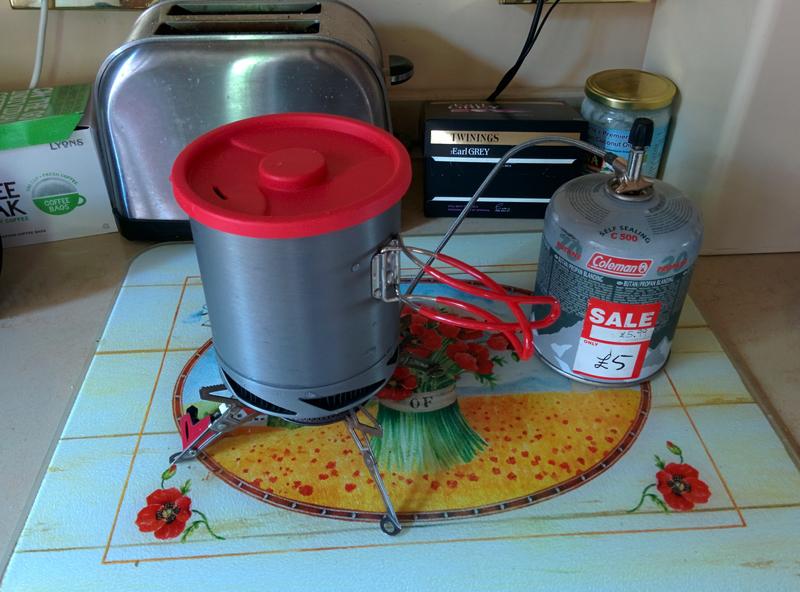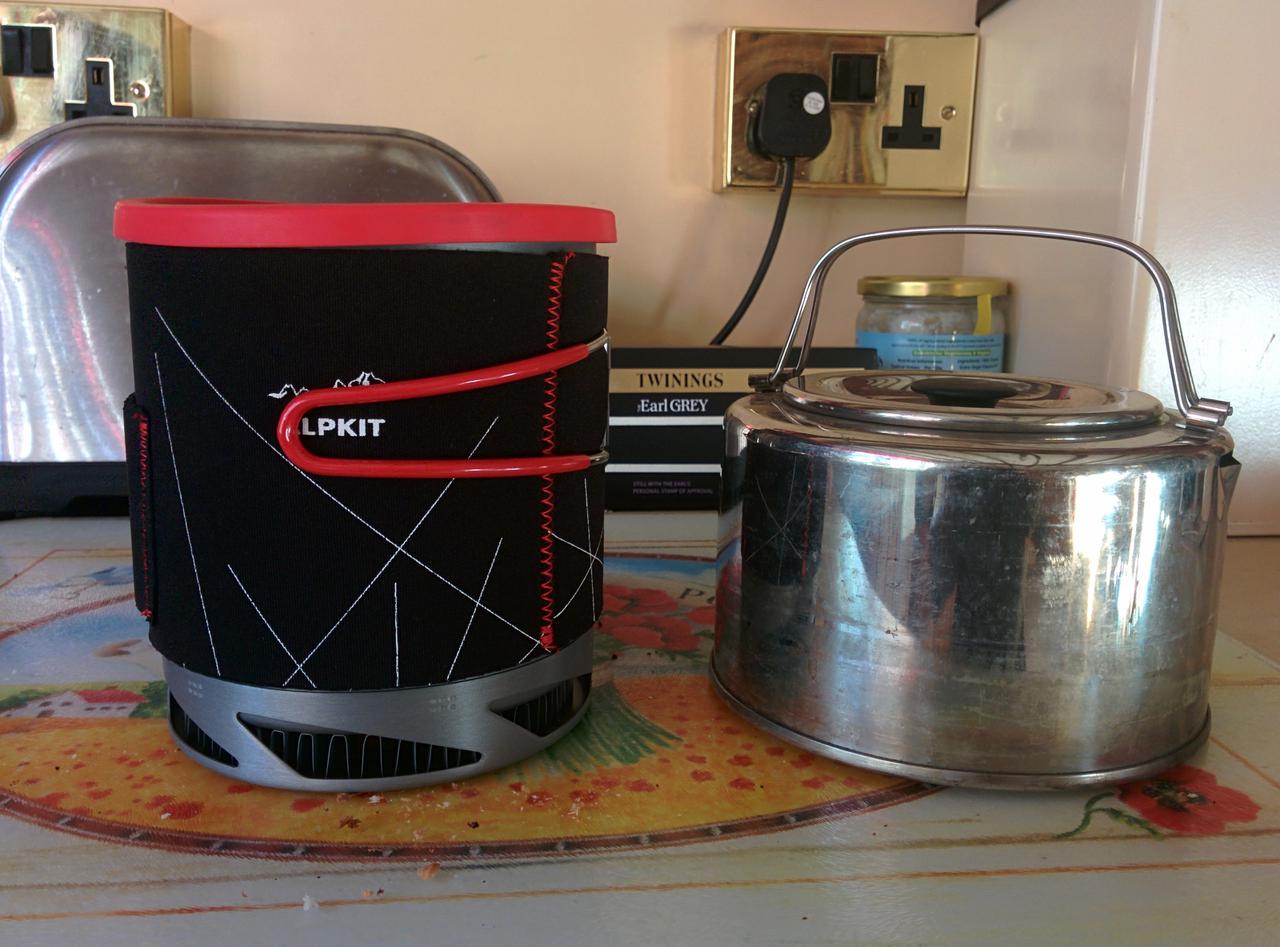Alpkit Brupot
I prefer gas for cooking and my stove of choice is the Primus Gravity. This is a remote canister stove, with a pre-heater, which makes it suitable for use in colder weather. Almost all my camping cooking is just a matter of boiling water to make a hot drink, or prepare a freeze dried meal.
I have looked at Jetboil stoves, but decided that they weren't for me because they were too heavy and the long tall shape makes them potentially unstable. However, if I needed to melt snow they would probably be my primary choice. One thing I haven't seen other manufacturers make is a cooking pot with a heat exchanger on the bottom, which could potentially improve the performance of a normal gas stove. However, Alpkit have now made a cooking pot with built in heat exchanger. I decided to buy one with the hope that it would reduce the time it takes to boil water on my stove and potentially save gas.
Alpkit BruPot test setup

The Brupot was delivered with the typical rapid efficiency. I wanted to compare it to my MSR stainless steel kettle, which is my usual cooking pot. Both vessels hold 1 litre of liquid, but the Brupot is slightly slimmer and therefore narrower. The Brupot has a plastic detachable lid, with a drinking slot so you can use it as a cup. It has detachable handles, which are covered in plastic so you don't burn your hands. There is a tightly fitting neoprene sleeve, which acts as a pot cosy. However, Alpkit recommends that you remove this when cooking. Since the sleeve is a tight fit, it's effectively useless. Can you image trying to fit a tight sleeve round a pot full of boiling water without burning your hands?
Alpkit BruPot and MSR kettle

I decided to do a head to head to see how long each pot would take to boil 500ml of water. I used my Primus stove with a full 500g canister. The test was conducted in the kitchen, so I didn't bother using a wind shield. I adjusted the flame on the stove so it didn't come round the sides of the pot and I didn't alter the flame setting when I swapped the pans. Each pan was filled with 500ml of cold water from the tap and placed on the stove.
I measured the time it took a continuous jet of steam to appear, which should correspond to a rolling boil. I didn't take the top off either pan off while it was heating the water, as this would increase the time to get a rolling boil. Thus there may have been a small error in judging when a pot was actually boiling. Also I didn't conduct another test with no lids on the pots, which would have made it easier to see if there was a rolling boil, as this isn't the way I use the pot when camping. I repeated the test three times. Between each set of repeat experiments I turned off the gas, then re-lit the stove , so the times for each run can't be summed to give an average, as the gas flow was probably different for each run.
Much to my surprise the Alpkit BruPot was slower to reach a rolling boil than the MSR, by about ten seconds in each test. That's not a big difference, but I was expecting the BruPot to be significantly faster because of the heat exchanger. I like the BruPot and it will probably replace my MSR kettle, because the handles and top are better. However, it seems that the heat exchanger doesn't work for my use case.
The Alpkit Brupot weighs 266g, including the bag and my MSR kettle weighs 254g.
Update.
It was pointed out to me that I really should also be measuring the weight of gas used. In my original experiment I didn't weight the gas canister. I believe my conclusions were valid as I didn't alter the gas flow between swapping pots and I was starting with a full 500g canister, so I would have expected flow to remain almost constant, so the weight of gas consumed would be the same. Also in the second run I swapped the order of the pots in the test, which should have shown up any differences caused by changes in gas flow between tests. In both cases the MSR boiled faster.
However, in the interests of accuracy I repeated my experiment and weighed the gas canister at the beginiing and end of each test.The first time I did this I kept the canister attached to the stove and stood the canister on top of the scales. I didn't alter the setting of the valve between pots, but did note the weight of the canister before and after the pot boiled. I did two separate runs, restarting the stove for each run.
Water was from the cold tap, which was allowed to flow for a couple of minutes first, so all the water used shuld have had the same starting temperature.
Whilst I believe that the boil times are comparable within each run, the effect of the hose attached to the top of the canister meant that the weights probably were not accurate. So, I repeated the whole thing again, but this time removed the gas canister from the pipe before weighing it. Since when I re-lighted the stove, I couldn't be certain that I was using the same flow rate I believe that the times for this set of results are not comparable, but the weight of gas consumed is.
Gas Cylinder Removed Before Weighing.
| Start Weight | End Weight | Gas Used | Time to boil |
|---|---|---|---|
| 513 | 501 | 12 | 4:26 |
| 493 | 480 | 13 | 3:54 |
| Start Weight | End Weight | Gas Used | Time to boil |
|---|---|---|---|
| 501 | 493 | 8 | 4:12 |
| 480 | 469 | 11 | 3:20 |
Gas Cylinder Weighed Without Removing From Flexible Pipe.
| Pot | Start Weight | End Weight | Gas Used | Time to boil |
|---|---|---|---|---|
| Alpkit | 599 | 584 | 15 | 4:09 |
| MSR | 545 | 534 | 11 | 3:30 |
| Pot | Start Weight | End Weight | Gas Used | Time Time to boil |
|---|---|---|---|---|
| Alpkit | 572 | 555 | 17 | 3:52 |
| MSR | 583 | 573 | 10 | 3:31 |
Conclusions.
The difference in performance between the BruPot and the MSR kettle are quite small and probably have little effect in real world use. The only real surprise is that in my setup the hest exchanger doesn't seem to have any positive effect. However, I still like the Alpkit BruPot and one advantage over my MSR is I can fit a 200g gas canister inside it.